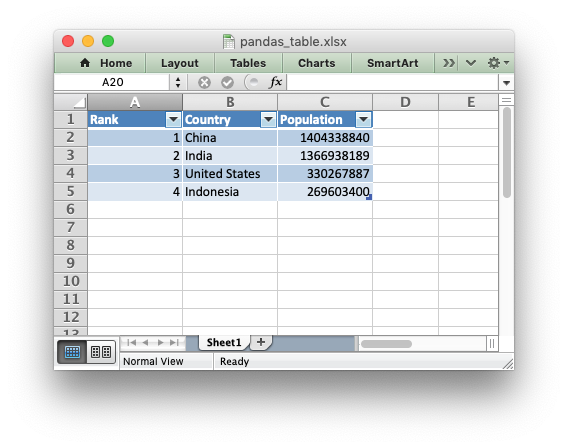Example: Pandas Excel output with a worksheet table#
An example of inserting a Pandas dataframe into an Excel worksheet table file using Pandas and XlsxWriter.

############################################################################## # # An example of adding a dataframe to an worksheet table in an xlsx file # using Pandas and XlsxWriter. # # Tables in Excel are used to group rows and columns of data into a single # structure that can be referenced in a formula or formatted collectively. # # SPDX-License-Identifier: BSD-2-Clause # # Copyright (c) 2013-2025, John McNamara, jmcnamara@cpan.org # import pandas as pd # Create a Pandas dataframe from some data. df = pd.DataFrame( { "Country": ["China", "India", "United States", "Indonesia"], "Population": [1404338840, 1366938189, 330267887, 269603400], "Rank": [1, 2, 3, 4], } ) # Order the columns if necessary. df = df[["Rank", "Country", "Population"]] # Create a Pandas Excel writer using XlsxWriter as the engine. writer = pd.ExcelWriter("pandas_table.xlsx", engine="xlsxwriter") # Write the dataframe data to XlsxWriter. Turn off the default header and # index and skip one row to allow us to insert a user defined header. df.to_excel(writer, sheet_name="Sheet1", startrow=1, header=False, index=False) # Get the xlsxwriter workbook and worksheet objects. workbook = writer.book worksheet = writer.sheets["Sheet1"] # Get the dimensions of the dataframe. (max_row, max_col) = df.shape # Create a list of column headers, to use in add_table(). column_settings = [{"header": column} for column in df.columns] # Add the Excel table structure. Pandas will add the data. worksheet.add_table(0, 0, max_row, max_col - 1, {"columns": column_settings}) # Make the columns wider for clarity. worksheet.set_column(0, max_col - 1, 12) # Close the Pandas Excel writer and output the Excel file. writer.close()